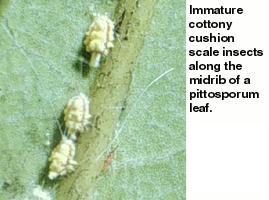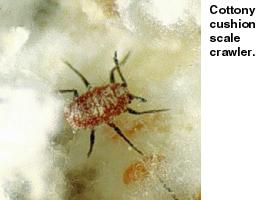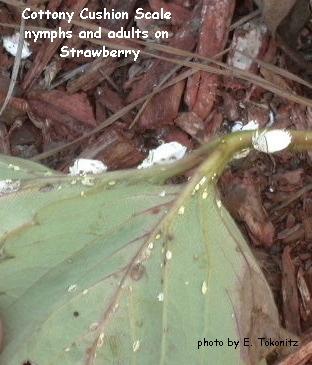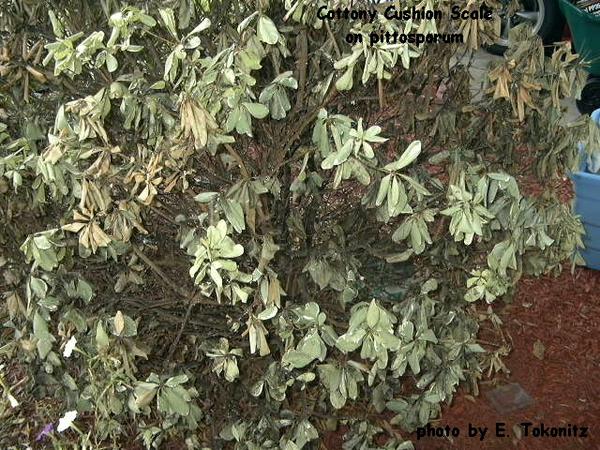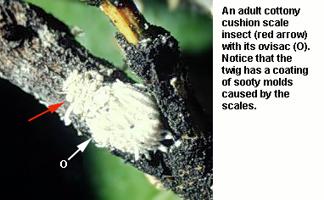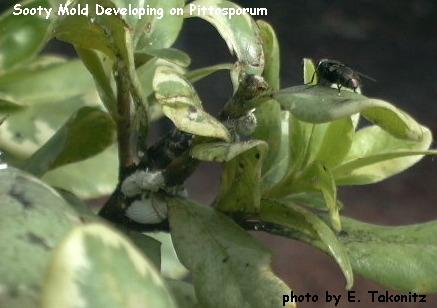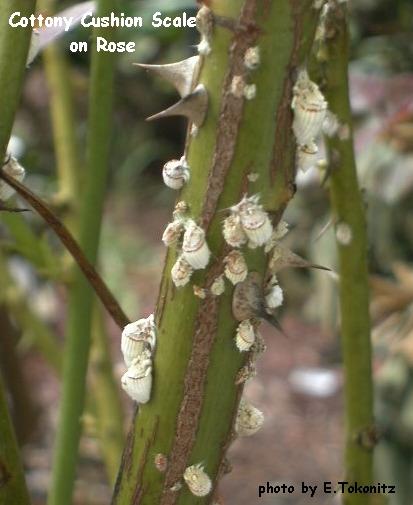General Information
Female cottony cushion scales are rusty red with black legs and antennae. They are about 4.5mm long. The mouthparts are the piercing/ sucking type. The body is often obscured by wax. Male cottony cushion scales are small (3mm), slender, reddish-purple insects with 2 metallic blue wings.
The ovisac contains reddish oval eggs. The 3⁄8 inch ovisac is fluted with 14 to 16 ridges. Its ovisac is pure white and is actually a doughy wax on the outside and fluffy or cottony wax inside. Tiny first nymphs are red with dark legs and antennae. Second nymph are usually covered with wax and tiny hairs. Third nymphs are usually covered with wax and fine hairs. They are about 1⁄8 inch long.
Biology
The cottony cushion scale is found throughout tropical and subtropical areas. In the United States, this pest is found in southern California, Arizona, the Gulf Coast states and North Carolina at least as far north and west as Raleigh. Winter temperatures of -12°C (about 10°F) are said to limit the spread of cottony cushion scales outdoors, although it can survive in greenhouses in much colder climates.
Although cottony cushion scale is often found on many different host plants, in North Carolina, nandina and pittosporum are the most frequently reported hosts. Immature cottony cushion scales debilitate plants by sucking out sap. They excrete honeydew, a sweet, sticky liquid which coats infested plants. Dark fungi called sooty molds grow in the honeydew. Heavily infested plants become chlorotic but darkened. Leaves and fruit drop prematurely, and heavily infested plants may die during periods of stress. Cottony cushion scale is unique in several ways. After its introduction into California from Australia in 1868 or 1869, cottony cushion scale devastated citrus there. In 1888, a lady beetle called the vedalia lady beetle or vedalia (Rodolia cardinalis (Mulsant)) was introduced from Australia and within 18 months the cottony cushion scale was reduced to a nonpest status. This was the first successful biological control of an insect pest.
Each female lays a large number of eggs in a dense, fluted ovisac from which this insect gets its name. This ovisac is made of wax secreted from the lower side of the scale. Three weeks (summer) to 8 weeks (winter) after being laid, the eggs hatch to first nymphs. In most scales, this stage is called the crawler but most stages of the cottony cushion scale can crawl. The first nymphs can crawl up to 1 yard in 10 minutes, and they tend to crawl up to the leaves and twigs to feed. After 2 or 3 weeks (much longer in winter), they molt into second nymphs which also soon secrete a layer of wax. After 2 or 3 weeks, the second nymphs molt to become third nymphs. In many cottony cushion scale infestations, males are rare or nonexistent.
Female third nymphs crawl from the leaves and small twigs down to the larger branches and trunk. After feeding from 3 to 7 weeks (longer in winter), these nymphs molt to adults. Adult females probably do not feed after they begin to lay eggs. They can produce normal ovisacs and lay eggs away from the host plant. Females can mate as soon as they molt from the third nymph. Unmated females often wait 11 to 17 days before laying eggs. It takes about two weeks for a female to lay her eggs. Females may live 2 to 3 months, particularly in winter. Outdoors, cold weather slows development in all stages drastically. There are probably 2 to 2.5 generations per year in North Carolina.
Control
Perhaps because the cottony cushion scale is an introduced pest, it has few predators and parasites. The vedalia, a small, reddish-orange, spotted lady beetle, is highly effective in controlling cottony cushion scale, but vedalias are more susceptible to pesticides than are scales. Vedalias also are active only at warm temperatures so that the scales can outstrip the vedalias in spring and fall. A parasitic fly, Cryptochaetum iceryae (Williston), has been introduced from Australia, but its importance in North Carolina is unknown.
Perhaps only Safari is specifically labeled for cottony cushion scale control; however, several insecticides are labeled for control of scales or scale crawlers. The following are suitable for use on ornamental plants. Be sure to read the label of each pesticide and follow the directions for safe use given on it. Products containing imidacloprid and dinotefuran have given disappointing results. Imidacloprid has also been indicated as having negative long term effects on lady beetles.
The use of a spreader-sticker is recommended for cottony cushion scale control to aid in the penetration of the pesticide into the ovisac and through the wax covering the scales.
Other Resources
- Common name: cottony cushion scale, scientific name: Icerya purchasi Maskell (Insecta: Hemiptera: Margarodidae). Hamon, A. B. and T. R. Fasulo. 1998 (rev. 2005, reviewed 2014). Entomology & Nematology, FDACS, DPI, EDIS. Pub. No. EENY-34
- NC State Extension Plant Pathology Publications and Factsheets
- NC State Horticultural Science Publications
- North Carolina Agricultural Chemicals Manual
For assistance with a specific problem, contact your local Cooperative Extension center.
Publication date: Aug. 1, 2010
Reviewed/Revised: Sept. 18, 2019
Recommendations for the use of agricultural chemicals are included in this publication as a convenience to the reader. The use of brand names and any mention or listing of commercial products or services in this publication does not imply endorsement by NC State University or N.C. A&T State University nor discrimination against similar products or services not mentioned. Individuals who use agricultural chemicals are responsible for ensuring that the intended use complies with current regulations and conforms to the product label. Be sure to obtain current information about usage regulations and examine a current product label before applying any chemical. For assistance, contact your local N.C. Cooperative Extension county center.
N.C. Cooperative Extension prohibits discrimination and harassment regardless of age, color, disability, family and marital status, gender identity, national origin, political beliefs, race, religion, sex (including pregnancy), sexual orientation and veteran status.

